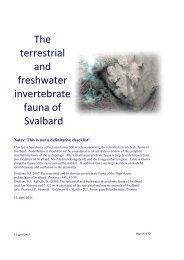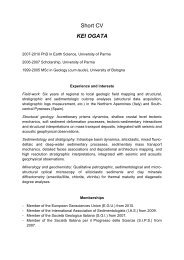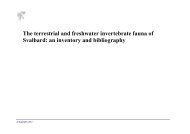Arctic plant ecology: From tundra to polar desert in Svalbard - Unis
Arctic plant ecology: From tundra to polar desert in Svalbard - Unis
Arctic plant ecology: From tundra to polar desert in Svalbard - Unis
Create successful ePaper yourself
Turn your PDF publications into a flip-book with our unique Google optimized e-Paper software.
Biodiversity <strong>in</strong> the High <strong>Arctic</strong>: species richness at<br />
selected sites <strong>in</strong> <strong>Svalbard</strong>, 7880°N<br />
Henrik An<strong>to</strong>nsson 1 , Marte Holten Jørgensen 2 , and Ane Christensen Tange 3<br />
1 Department of Plant and Environmental Sciences, Göteborg University. Box 460 S405 30 Göteborg,<br />
Sweden. Email: henrik.an<strong>to</strong>nsson@dpes.gu.se. 2 Program for Molecular Ecology and Biosystematics,<br />
Department of Biology, University of Oslo, P.O. Box 1066 Bl<strong>in</strong>dern, NO0316 Oslo, Norway.<br />
3 Department of Biology, Norwegian University of Science and Technology, NTNU NO7491<br />
Trondheim, Norway.<br />
Abstract<br />
Biodiversity is <strong>to</strong>day greatly endangered by human activities, particularly <strong>in</strong> the<br />
vulnerable <strong>Arctic</strong>. We studied 15 <strong>plant</strong> communities <strong>in</strong> the arctic archipelago of<br />
<strong>Svalbard</strong> (7880°N) distributed <strong>in</strong> three different bioclimatic zones <strong>in</strong> search for<br />
differences <strong>in</strong> species richness, and causes for these. We recorded biodiversity as po<strong>in</strong>t<br />
frame <strong>in</strong>terceptions (0.25 m 2 ; 25 po<strong>in</strong>ts), species present <strong>in</strong> frames, and species lists<br />
for each site visited, and compared them with major environmental fac<strong>to</strong>rs; soil<br />
temperature, soil moisture, soil pH, exposure, slope angle, bioclimatic zones, and<br />
productivity. The result<strong>in</strong>g dataset was analysed us<strong>in</strong>g KruskalWallis tests, Kendall’s<br />
τ correlations, ANOVA and ord<strong>in</strong>ation methods (PCA and RDA). Our results suggest<br />
that: species diversity, on a landscape as well as local scale, decreases <strong>in</strong> relation <strong>to</strong><br />
bioclimatic zones (from C <strong>to</strong> A). Ord<strong>in</strong>ation methods implied that species richness is<br />
correlated with bioclimatic zones, soil temperature, production and ground cover. We<br />
conclude that biodiversity <strong>in</strong> the <strong>Arctic</strong> is highly scaledependent and that this model<br />
needs more test<strong>in</strong>g, <strong>in</strong> order for policymakers <strong>to</strong> make wise decisions on conservation<br />
of <strong>Arctic</strong> environments.<br />
Keywords: <strong>Arctic</strong>, bioclimatic zones, biodiversity, <strong>plant</strong>s, species richness, <strong>Svalbard</strong><br />
Introduction<br />
Human activities are reduc<strong>in</strong>g the number of species worldwide at a rapid pace with<br />
potentially devastat<strong>in</strong>g effects on ecosystem services, and <strong>in</strong> the long run economical<br />
and social consequences (Hooper et al. 2005). Climate changes <strong>in</strong>duce migration of<br />
species, loss of some species, replacement of some and arrival of <strong>in</strong>vad<strong>in</strong>g species <strong>in</strong><strong>to</strong><br />
<strong>plant</strong> communities. Proof for this pattern has been published from numerous sites<br />
along the <strong>tundra</strong> and the <strong>Arctic</strong>, from experimental warn<strong>in</strong>g experiments (Walker et<br />
al.2006), as well as real changes <strong>in</strong> vegetation (Kullman 2000, Truong 2003). This<br />
may cause largescale changes <strong>in</strong> community composition, which surely will have a<br />
detrimental effect on arctic and alp<strong>in</strong>e ecosystems. Concerns for loss of biodiversity<br />
are raised throughout the world and <strong>in</strong>vestigations on what fac<strong>to</strong>rs are most important<br />
<strong>in</strong> determ<strong>in</strong><strong>in</strong>g biodiversity are heavily debated <strong>in</strong> the scientific community. Increas<strong>in</strong>g<br />
our knowledge on this issue is not merely of academic <strong>in</strong>terest, but of great importance<br />
<strong>in</strong> order <strong>to</strong> predict short and longterm effects of climate change on arctic <strong>tundra</strong>.<br />
The first general model concern<strong>in</strong>g what determ<strong>in</strong>es <strong>plant</strong> diversity was developed by<br />
Grime (1973). His humpback or <strong>in</strong>termediate disturbance model of <strong>plant</strong> species<br />
density predicted that species richness is depend<strong>in</strong>g on level of stress and production.<br />
Follow<strong>in</strong>g Grime, a large number of studies on this <strong>to</strong>pic have been published, most of<br />
11








